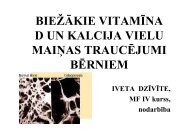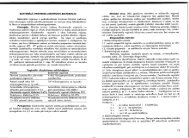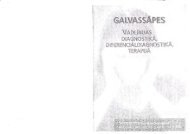PHYSICS
n - susliks.lv
n - susliks.lv
- No tags were found...
Create successful ePaper yourself
Turn your PDF publications into a flip-book with our unique Google optimized e-Paper software.
GaAlAs-laser<br />
InGaAs-laser<br />
He: Ne-Iaser I I N:d- YAG-Iaser<br />
100 , " I<br />
Hemoglobin<br />
~<br />
80 ~<br />
\~<br />
r= §<br />
I<br />
-- - -<br />
~<br />
r=<br />
r=<br />
0 = I::<br />
::::.<br />
I::~<br />
:;::<br />
\Cl<br />
Q l/')<br />
.c 60 \Cl<br />
...<br />
-<br />
00 Q Q Q<br />
0<br />
r- C'\<br />
.c '"<br />
~ 40<br />
20<br />
0<br />
-<br />
CO 2-laser<br />
400 600 1000 4000 8000 10000<br />
Wavelenth, nm<br />
Fig. 23.3. The "therapeutic window" the spectral region between<br />
600 and 1300 nm due to absorption by water and pigments<br />
A portion of this segment of the spectrum is characterized by a<br />
high reflection and transmission of radiation by green leaves. Foliar<br />
pigments, as well as cellulose found in the cell wall region,<br />
are transparent in the near-infrared part (700 - 1300 nm) of<br />
spectrum. For this reason, the quantity of radiation absorbed by<br />
the leaf is very small (:S; 10%) with the remaining radiation either<br />
reflected or transmitted. In the 1300 - 2500 nm region, the<br />
optical properties of leaves are strongly affected by their water<br />
content.<br />
23.5. ULTRAVIOLET THERAPY<br />
Ultraviolet Therapy is a treatment used for several skin diseases<br />
and to relieve certain forms of itching. Ultraviolet (UV) radiation<br />
may be administered directly or in conjugation with photoactive<br />
drugs. The most common application of UV radiation is in the<br />
treatment of psoralen ultraviolet A (PUVA). It is also used for the<br />
176<br />
treatment of psoriasis and several other skin disorders. The treatment<br />
involves a combination of the photoactive drug psoralen<br />
with long-wave ultraviolet (UV-A) radiation. The mechanism of<br />
action is thought to be via the binding of psoralen (particularly<br />
8-methoxypsoralen) to DNA in the presence of UV-A, resulting<br />
in a transient inhibition of DNA synthesis and cell division.<br />
Typical intensities used are -100 W1m 2 • Ultraviolet radiation is<br />
also widely used for severe cases of psoriasis that have not responded<br />
to other medications or in cases affecting large portions<br />
of the body. Other skin disorders such as vitiligo and atonic dermatitis<br />
can also be treated with UV radiation.<br />
Ultraviolet Irradiation of Blood. Based on experimental investigations<br />
and clinical observations, it is possible to form a hypothesis<br />
about the positive effect of a small quantity of ultraviolet<br />
irradiated blood that is reinfused into an organism. The procedure<br />
is thought to confer a bacteriological effect, deactivate toxins,<br />
and increase the organism's resistance to infection. The method<br />
utilizes ultraviolet (UV-C) illumination of blood flowing from a<br />
vein through a quartz cuvette and then back into the animal. It has<br />
been used for the treatment of calves with bronchopneumonia,<br />
dyspepsia, rinotraheitis; cows with several hoof diseases; and horses<br />
with inflammatory ailments.<br />
The primary photoreaction induced in the blood by UV-irradiation<br />
is the photoionization of free aromatic amino acids that<br />
results in the loss of activity of critical regulatory and immunologic<br />
proteins. The photodestruction of these proteins leads to the<br />
formation of both high- and low-molecular weight compounds<br />
with new structures and spectral properties. The new products<br />
have an antigenic nature and induce the formation of antibodies<br />
that confer polyimmunization to the organism.<br />
23.6. PHOTOTHERAPY<br />
Phototherapy is treatment for certain diseases of the skin using<br />
the application of light.<br />
Red Light Phototherapy. Recently, numerous scientific papers<br />
and biomedical conference proceedings have focused on the therapeutic<br />
effect of red light, such as that from He:Ne lasers. The<br />
most promising clinical uses for He:Ne lasers have been for the<br />
177






